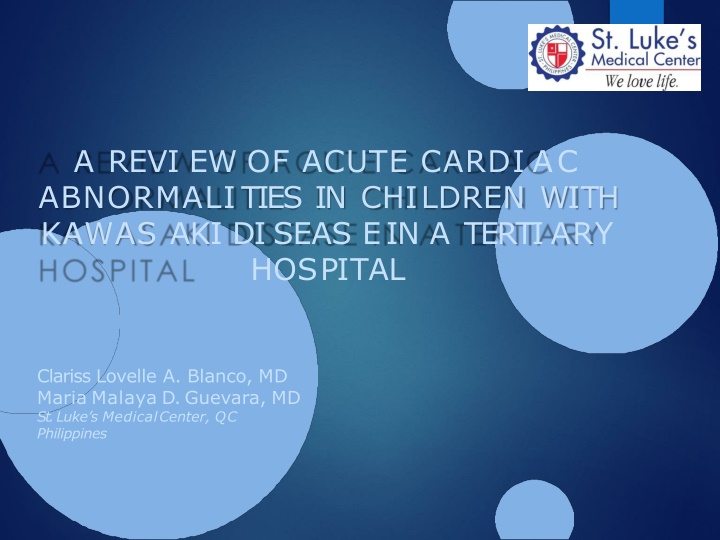
Acute Cardiac Abnormalities in Children with Kawasaki Disease
Explore the prevalence of acute cardiac abnormalities in children with Kawasaki disease, a leading cause of acquired heart disease in developed countries. This review discusses the various cardiac sequelae and highlights the higher risk of coronary artery aneurysms in Filipino children compared to other ethnic groups. The literature reveals conflicting results on risk factors for coronary artery lesions, emphasizing the need for continuous monitoring and further research in understanding this complex disease.
Download Presentation

Please find below an Image/Link to download the presentation.
The content on the website is provided AS IS for your information and personal use only. It may not be sold, licensed, or shared on other websites without obtaining consent from the author. If you encounter any issues during the download, it is possible that the publisher has removed the file from their server.
You are allowed to download the files provided on this website for personal or commercial use, subject to the condition that they are used lawfully. All files are the property of their respective owners.
The content on the website is provided AS IS for your information and personal use only. It may not be sold, licensed, or shared on other websites without obtaining consent from the author.
E N D
Presentation Transcript
A REVI EW OF ACUTE CARDI AC ABNORMALI T I ES I N CHI LDREN WI TH KAWAS AKI DI S EAS E I N A TERTI ARY HOS PI TAL Clariss Lovelle A. Blanco, MD Maria Malaya D. Guevara, MD St. Luke s MedicalCenter, QC Philippines
INTRODUCTION AND LITERATUREREVIEW Kawasaki disease (KD) is the leadingcause of acquired heart disease among children in developed countries1,2 Various cardiac sequelae that account for most of the morbidity and mortality of Kawasaki disease Myocarditis, pericardial effusions, coronary artery aneurysms or ectasia, ischemic heart disease, and even sudden death3 1. 2. Kliegman, R, et.al 2007, Nelson s textbook of Pediatrics 18th edition, Saunders Elsevier, Philadelphia, PA. Kawasaki syndrome: an intriguing disease with numerous unsolved dilemmas. Falcini F, Capannini S, Rigante D. Pediatr Rheumatol Online J. 2011 Jul 20;9:17. Kawasaki disease: etiology, pathogenesis and treatment. Barron, K. Cleveland Clinic Journal of Medicine. 2002; 69-II:69-78. 3.
Filipino children with KD believed to be at higher riskof developing coronary artery aneurysms than other Asian and non-Asian children. The aneurysm rate was 23.8%, 10.5% and 7.8%for Filipinos, non-Filipino Asians and all other groups,respectively.4 4. Manzano, Elvira. Filipino children at higher risk of severe Kawasaki disease. Medical Tribune. MIMS Philippines., May 2011. Web. 5 December 2014
Many studies done abroad have sought to identify risk factors for coronaryartery lesions (CAL) secondary toKD Conflicting results on the riskfactors for CAL
Variability in reported clinical and laboratory findings associated with coronary artery involvement in KD. 5 5. Can coronary artery involvement in Kawasaki Disease be predicted? Ghelani S, Kwatra N, Spurney C. Diagnostics. 2013; 3, 232-243; doi:10.3390/diagnostics3020232.
Local literature about KD has been scarce Most of the few Philippine studies have had small populations with usual focus only on the disease profile Continuous monitoring of KD iscritical to gain a better understanding of the global extent of this complex disease.7 7. Epidemiology of Kawasaki disease in Asia, Europe, and the United States. Uehara, R and Belay, E. Journal of Epidemiology. 2012; 22:2.
RESEARCHOBJECTIVES GENERAL OBJECTIVE To describe the acute cardiac abnormalities in children with Kawasaki disease at St.Luke s Medical Center- Quezon City (SLMC-QC) and to identify a correlation of clinical and laboratory findings with these acute cardiac abnormalities
SPECIFICOBJECTIVES To describe clinical and demographic data on cases of KD atSLMC-QC Todescribe the acute cardiac abnormalities seen in children with KD atSLMC-QC
To compare KD patients with or without acute cardiac involvement according to clinical and laboratory parameters suchas: Age Sex Presence or absence of each of the principal criteria Atypical/incomplete presentation Laboratory findings
SCOPE AND LIMITATIONSOF THESTUDY This study is limited to cases of Kawasaki Disease in St Luke s Medical Center, Quezon City, Philippines from January, 2004to December,2013 Relied heavily on the completeness and accuracy of the chart retrieval system of the hospital s Medical Records section and on the completeness and accuracy of chart entries as well
Echocardiogram findings subjectto the interpretation of the pediatric cardiologist Laboratory results were checked,compared and confirmed for accuracy with the St. Luke s Healthcare System Both ESRand CRP were not done in all patients
METHODOLOGY Retrospective cross sectionalstudy Conducted at St.Luke s Medical Center Quezon City (SLMC-QC) Medical records of children aged 0 to 18 years old discharged from SLMC-QC from January 2004 to December 2013 with the diagnosis, Kawasaki Disease (ICD 10 Code M30.3)
OPERATIONAL DEFINITIONS Kawasaki disease (epidemiological casedefinition) Fever Day of illness orfever Refractory Kawasakidisease Acute cardiacabnormalities Coronary artery lesionsdue to Kawasaki disease CBC, ESR,CRP
INCLUSION CRITERIA AND EXCLUSION CRITERIA Medical records Children aged 0-18 yearsold Discharged from SLMCQC January 2004 to December 2013 Diagnosis: KawasakiDisease Patients without any echocardiogram done during the admission wereexcluded
DESCRIPTION OF OUTCOME MEASURES Descriptivestatistics Measures of central tendency and measuresof dispersion Ratio and proportion for the frequency distribution of each variable Prevalence of patients with and without acute cardiac abnormalities
STATISTICALTREATMENT Means +SD Medians,IQR Proportions Two groups --KD patients with acute cardiac abnormalities and those without were compared in termsof a set of clinical and laboratory parameters Chi-square test or Fisher exact test tocompare proportions as appropriate Unpaired t test or Mann Whitney U testfor univariable analyses Type I error at0.05
RE SU L TS ANDDISCUSSION Table 1. Population profile Age Group(N=67) <6months 6-11months 1-5years 6-10years 11-15years 16-18years Age, in years,Median (IQR) Number 4 10 44 6 2 1 % 6.0 14.9 65.7 9.0 3.0 1.4 2(1-4) Number % Sex(N=67) Male Female 37 30 55.2 44.8
Table 1. Population profile, Contn Month ofAdmission January February March April May June July August September October November December Number 10 3 12 7 5 6 1 4 4 5 5 5 % 14.9 4.5 17.9 10.4 7.4 8.9 1.5 6.0 6.0 7.5 7.5 7.5
Table 1. Population profile, Contn Principal Clinical Featuresof KD Patients (N=67) Rash Eyes Oral Lymphnode Extremitychanges AtypicalPresentation (N = 67) Duration of Fever to Diagnosis or Time of Treatment with IVIG, Median (IQR) Number % 56 54 59 49 35 31 83.6 80.6 88.1 73.1 52.2 46.3 7(6-10)
Table 1. Population profile, Contn Laboratory Parameters in KD Patients Hematocrit(vol%), Median (IQR) WBC Count (/mm3), Mean +SD Platelet Count(/mm3), Mean +SD ESR(mm/hour), Mean +SD CRP (mg/dL), Median (IQR) 33.2 (30.5 35.3) 16,582 +6,731 462,363 +208,689 71 +30 48(24-96) Number 61 % 91.0 Patients IVIG(N=67) Refractory KD (N = 61) Treated with 5 8.1
Table 2. Acute Cardiac Abnormalities in KD Patients Number 59 % 88.1 AcuteCardiac Abnormalities (N = 67) (+) Cardiac Exam Findings (N = 67) Tachycardia Murmur Irregular heartrhythm (+) ECGFindings (N=13) Sinustachycardia Axisdeviation LVH Non specific ST-T wave changes Others 34 50.7 31 3 1 7 46.3 4.5 1.5 53.8 5 2 2 2 38.5 15.4 15.4 15.4 2 15.4 (1-Sinus pause /arrest; 1-RV conduction delay)
Table 2. Acute Cardiac Abnormalities in KD Patients, Contn Number (+) Echocardiogram Findings(N=63) Pericardial effusion Coronary artery dilatation/ ectasia Coronary artery aneurysm Perivascular brightness/ cuffing Mitral regurgitation Fair to lowEF LVH orenlargement Thickened mitralvalve Flattened septalmotion % 77.6 52 40 18 59.7 26.9 3 4.5 6 9.0 4 4 3 2 1 6.0 6.0 4.5 3.0 1.5
Table 3. Comparison of clinical and laboratory parameters between KD patients with and without acute cardiac abnormalities (p value <0.05considered statisticallysignificant) With Acute Cardiac Abnormaliti es Age, inyears, Median,IQR Male,% 57.6 Without Acute Cardiac Abnormalities pvalue 2.0(1-4) 1.5(0.6-5.8) 0.883 37.5 0.451 Rash,% 83.1 87.5 1.000 Eyes,% 81.4 75.0 0.647 Oral,% 89.8 75.0 0.242 74.6 62.5 0.672 Lymphadenopathy,% 52.5 50.0 1.000 Extremity changes, % Incomplete KD,% 44.1 62.5 0.456
Table 3. Comparison of clinical and laboratory parameters between KD patients with and without acute cardiac abnormalities,Cont n (p value <0.05considered statisticallysignificant) WithAcute Cardiac Abnormaliti es Hematocrit,% , Median(IQR) WBC count, /mm3, Mean + SD WithoutAcute Cardiac Abnormaliti es pvalue 33.1 (30.2 35.3) 34.8 (30.4 36.0) 0.191 16,267 +6,687 18,868 +7,061 0.309 0.731 Platelet count,/mm3, Mean + SD CRP,mg/dL, Median(IQR) ESR,mm/hr, 459,052 +209,053 486,375 +218,603 48 (24 96) 24(6-60) 0.080 70 +30 74 +34 0.819 Mean + SD
CONCLUSION Kawasaki disease in the SLMC-QC experience 86.6% of KD patients <5 yearsold Peak age of incidence: 2years old 1.2:1 male to femaleratio Peak occurrences between January to April Most frequently observed principal clinicalfeature: oral mucosal changes(88.1%) Hematocrit, WBC s, platelets, ESR, CRP
Kawasaki disease in the SLMC-QC experience (Continuation) 46.3 % incomplete or atypicalKD Median duration of the illnessto diagnosis or treatment with IVIG:7 (6-10)days 91% patients received IVIG infusion duringadmission 5 of 61 (8.1%) treated patients refractory toIVIG
Acute cardiac abnormalities in Kawasaki disease patients are very common and mostly non- specific, seen in 59(88.1%)of the 67 patients 50.7% with significant cardiac examfindings Most frequently observed cardiacexamination finding: Tachycardia (46.3%)
Acute cardiac abnormalities (Continuation) 77.6% with noteworthy results on echocardiogram Mostcommon echocardiogram finding: effusion(59.7%) 40.4% with coronary arterylesions Pericardial 7 of 13 patients(53.8%) with significant ECG findings
No significant difference in the clinical and laboratory parameters betweenKD patients with acute cardiac abnormalities and those without Accurate assessment for the riskof acute cardiac involvement in Kawasaki disease may be difficult
RECOMMENDATIONS Long term follow-up anddocumentation of cardiacfindings of KD patients Determine risk factors for coronaryartery lesions Large, localprospective study of Kawasaki disease patients, with only one cardiologist interpreting the echocardiograms to confirm the Filipinos risk for more serious cardiacsequelae4 4. Manzano, Elvira. Filipino children at higher risk of severe Kawasaki disease. Medical Tribune. MIMS Philippines., May 2011. Web. 5 December 2014
Heightened awareness ofKD Keep KD in the differential diagnosis of every child with fever of at least several days duration, rash, and nonpurulentconjunctivitis The American Heart Association s2004guidelines on KD remains to be a helpful tool for physicians in the diagnosis and management of these patients
Other problem areas that need to be addressed by future studies: Difficulties in early identification of the atypical and incomplete cases Coronary artery injuriesin children not fulfilling the classic diagnostic criteria Genetic predisposition to Kawasakidisease Vascular dysfunction in patients not showing echocardiographic evidence of coronary artery abnormalities in the acute phase of Kawasaki disease Risk of potential prematureatherosclerosis.2 2. Kawasaki syndrome: an intriguing disease with numerous unsolved dilemmas. Falcini F, Capannini S, Rigante D. Pediatr Rheumatol Online J. 2011 Jul 20;9:17.






















